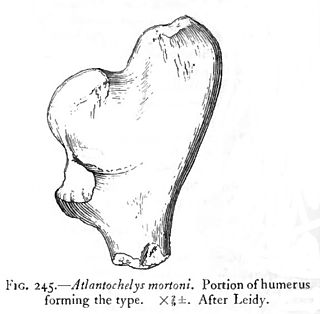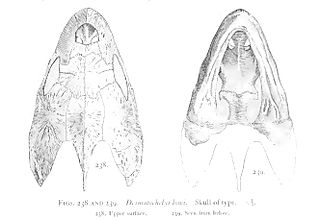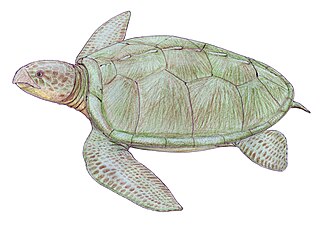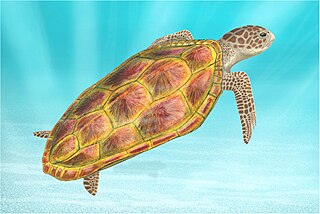 W
WProtostegidae is a family of extinct marine turtles that lived during the Cretaceous period. The family includes some of the largest sea turtles that ever existed. The largest, Archelon, had a head one metre (39 in) long. Like most sea turtles, they had flattened bodies and flippers for front appendages; protostegids had minimal shells like leatherback turtles of modern times.
 W
WArchelon is an extinct marine turtle from the Late Cretaceous, and is the largest turtle ever to have been documented, with the biggest specimen measuring 460 cm (15 ft) from head to tail, 400 cm (13 ft) from flipper to flipper, and 2,200 kg (4,900 lb) in weight. It is known only from the Dakota Pierre Shale and has one species, A. ischyros. In the past, the genus also contained A. marshii and A. copei, though these have been reassigned to Protostega and Microstega, respectively. The genus was named in 1895 by American paleontologist George Reber Wieland based on a skeleton from South Dakota, who placed it into the extinct family Protostegidae. The leatherback sea turtle was once thought to be its closest living relative, but now, Protostegidae is thought to be a completely separate lineage from any living sea turtle.
 W
WArchelon is an extinct marine turtle from the Late Cretaceous, and is the largest turtle ever to have been documented, with the biggest specimen measuring 460 cm (15 ft) from head to tail, 400 cm (13 ft) from flipper to flipper, and 2,200 kg (4,900 lb) in weight. It is known only from the Dakota Pierre Shale and has one species, A. ischyros. In the past, the genus also contained A. marshii and A. copei, though these have been reassigned to Protostega and Microstega, respectively. The genus was named in 1895 by American paleontologist George Reber Wieland based on a skeleton from South Dakota, who placed it into the extinct family Protostegidae. The leatherback sea turtle was once thought to be its closest living relative, but now, Protostegidae is thought to be a completely separate lineage from any living sea turtle.
 W
WAtlantochelys is an extinct genus of sea turtle from the Upper Cretaceous of New Jersey. For 163 years, only a partial humerus was known, but the second part of the same bone was found in 2012. The full size has been extrapolated as being 3 m (9.8 ft).
 W
WChelosphargis is an extinct genus of sea turtle from Upper Cretaceous of Alabama. Only one species has been described, Chelosphargis advena.
 W
WDesmatochelys is an extinct genus of sea turtles belonging to the family Protostegidae. This genus contains two known species, D. lowii and D. padillai. D. lowii was first discovered in 1895, followed by D. padillai in 2015. Having been estimated at over 120 million years old, D. padillai is currently the oldest known species of sea turtle.
 W
WDesmatochelys padillai is an extinct species of sea turtle described in 2015 and belongs to the family Protostegidae. Estimated to be more than 120 millions years old, it became the oldest known sea turtle, superseding a record earlier held by Santanachelys gaffneyi, which was described in 1998. The fossil, including bones and shells, was discovered from Villa de Leyva in Colombia in 2007. The specimen is larger than an average-sized human, measuring 2 m in length, and exhibits the key features of modern sea turtles. The specific name is given in honour of Carlos Bernardo Padilla, a renowned supporter of the palaeontology of the region.
 W
WNotochelone is an extinct genus of sea turtle, which existed about 100 million years ago. The species was first described by Richard Lydekker in 1889. It was the most common marine reptile living in the inlands of the sea around Queensland, Australia. It was a small turtle, and was about the same size as the modern green turtle. Analytical studies have indicated that the creatures frequently ate benthic molluscs.
 W
WOcepechelon is an extinct genus of giant protostegid sea turtle known from Late Cretaceous phosphatic deposits of the Oulad Abdoun Basin, Khouribga Province of Morocco. It is known from the holotype OCP DEK/GE 516, a complete but isolated 70-cm-long skull, making it one of the largest marine turtles ever described. It was first named by Nathalie Bardet, Nour-Eddine Jalil, France de Lapparent de Broin, Damien Germain, Olivier Lambert and Mbarek Amaghzaz in 2013 and the type species is Ocepechelon bouyai. The feeding apparatus of Ocepechelon, a bony pipette-like snout, is unique among tetrapods and shares unique convergences with both syngnathid fishes and beaked whales.
 W
WPneumatoarthrus is an extinct genus of sea turtle known from the Late Cretaceous Mount Laurel Formation of Monmouth County, New Jersey. only a single species, P. peloreus, is known.
 W
WProtostega is an extinct genus of sea turtle containing a single species, Protostega gigas. Its fossil remains have been found in the Smoky Hill Chalk formation of western Kansas and time-equivalent beds of the Mooreville Chalk Formation of Alabama. Fossil specimens of this species were first collected in 1871, and named by Edward Drinker Cope in 1872. With a length of 3 metres (9.8 ft), it is the second-largest sea turtle that ever lived, second only to the giant Archelon, and the third-largest turtle of all time behind Archelon and Stupendemys.
 W
WRhinochelys is an extinct genus of sea turtles belonging to the family Protostegidae.
 W
WSantanachelys gaffneyi is an extinct species of sea turtle. It is the only species in the genus Santanachelys, which itself is a member of the extinct family Protostegidae. The species was first described from a 20-centimeter long fossil specimen unearthed in 1998 from the Santana Formation of eastern Brazil. From the rock layer from which it was excavated, it was determined that the specimen was from the Early Cretaceous period. It is therefore one of the oldest known sea turtles. It was even recorded as the oldest sea turtle in Encyclopædia Britannica, but a new fossil named Desmatochelys padillai in 2015 is estimated to be as old as 120 million years.